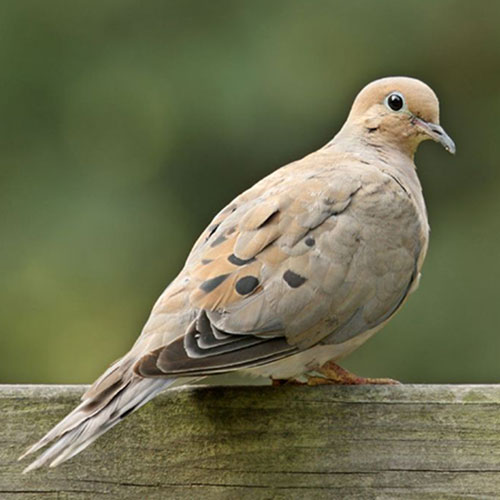
Feathered Friends
Doves have long been revered as a symbol of peace but the history of how the dove became so cherished has a few different tales. One is in the biblical story of Noah and the Arc. The dove was said to have returned to the Arc with a freshly plucked olive leaf symbolizing the end of the flood and the proof of land. In early religious art, the dove was used to represent peace of the soul. The story of the most revered image is that of the dove carrying an olive branch. This dates back centuries before any religious connections and is related to ancient Greece. Irene, the goddess of peace was very fond of the olive. To the ancient Greeks the olive tree represented abundance and protected against evil spirits. All of this combined, inspired Picasso to create a poster for world peace in 1949 where the image of the dove carrying the olive branch became the great symbol of peace as it is known today.

Mourning doves are a beloved bird to many who feed wild birds. The Mourning dove is a bird with many names. It was formerly known as the Carolina turtledove, then shortened to just turtledove. The current name represents their soft, haunting call that could definitely be described as a call of mourning. As treasured as doves may be to the soft at heart, they are surprisingly the leading gamebird in the U.S. Mourning doves are one of the most abundant birds in North America which may come as a surprise after seeing the following statistics. Twenty to seventy million Mourning doves are shot each year, mainly for sport but also for meat. To think they could be abundant at all with that kind of annual demise is truly shocking but their estimated population in North America is 450 million. Their flight speed of 88 km/hr makes them a challenge for hunters who consider them ‘live skeets’.
Mourning doves are about 12 inches in length with light grey and brown colouring and black mottling on the wings. They have a pinkish hue on the breast and a black crescent mark under the eye. The only difference between the male and female is that males have purple-pink patches on the sides of the neck and a bluish-grey crown on the head. One of their most notable traits is their ‘whistling wings’. The sound heard as they take off in flight, due to the anatomy of their wings. The contour of their flight feathers creates a high-pitched vibration when the wings flutter rapidly. Other species of birds consider this sound as a warning of potential predators.
During courtship the male performs graceful flight patterns. On the ground he will approach a female with his breast puffed out, bobbing his head, and making loud calls. The female selects the nesting site and builds the nest herself. The male assists by gathering nesting material and will stand on her back presenting her with twigs, blades of grass, and conifer needles. One of the Mourning doves most known skills, or lack of for that matter, is the construction of one of the most scant, if not pathetic nests of all nest builders. The eggs balance precariously on twigs and many do not make it. Doves will have up to six broods per season to make up for the high mortality. Usually only two eggs are laid but often a female will lay more eggs in the nest of another dove pair equalling about 4 eggs per clutch. The male incubates from morning to afternoon and the female completes the rest of the day and night. Incubation time is 14 days and the young will fledge in about 15 days. Both parents produce a milk that is fed to the chicks for the first few days of life and gradually seed is introduced. After leaving the nest, the young stay close to their father for an additional two weeks being fed by him while learning to fend for themselves.
To attract doves to your yard, offer white millet, black oil sunflower, and their absolute favourite food, safflower. This can be offered on a Platform feeder or in a shallow dish on the ground. A beautiful bird that offers such a peaceful, calming presence is a welcome addition to any yard.
Sherrie Versluis owns the Preferred Perch and is an avid birder.


Sherrie, Thank you for this very informative discussion. Will purchase proper food for this beautiful bird my next trip to your wonderful store.
I love the Doves. I usually get three each year then there is a pair. I feed them the Safflower I buy at your store. I have a stone with a dip in it under my Spruce and I fill every morning with a handful and they are usually waiting in the tree every morning for me to deliver. ? Nice that other birds don’t eat, sometimes grey squirrel samples
Great article, Sherrie! I see the doves every year but they never seem to come to the feeder for the sunflower seeds. I’ve heard that millet will attract tons of sparrows, which I don’t specifically want. Is that true? Also, what other birds will eat safflower if purchase some?